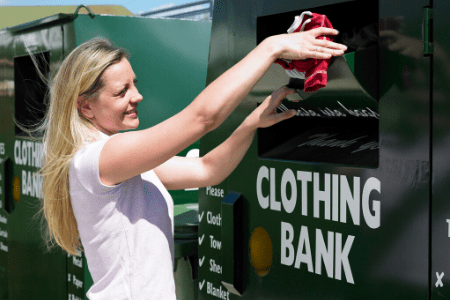Cleaning before moving can be overwhelming. Even in just one year, many of us accumulate a lot of stuff. Whether you live in a small apartment by yourself, or a larger home with a family, using a step-by-step process can help you declutter before a move.
Cleaning and Packing
What to keep?
Sorting your items is a big task, but it will save you time and money in the process. You don’t want to move things you don’t really use. Here are a few key points to consider.
Cleaning closets and other time-consuming spaces
Closets are used to store things we don’t use regularly, so they will take more time. The garage, den, home office, basement are all areas that will take longer. Tackle them  early rather than leaving them to the last minute.
early rather than leaving them to the last minute.
Packing always takes longer than we think. You might run out of time and have to pack things you really don’t need.
Make a list
Go through each room and make a list of what you want to keep and what you want to donate. Keep this list to the absolute essentials – the things you know for sure you’re moving.
If you’re moving everything yourself, then think about how much you want to pack and what you can fit in the moving truck. Try to be realistic. Every box will cost you money if you are using a moving company.
Remove everything from the space
When sorting closets, take everything out. Sorting a room? Make sure everything is out of boxes and removed from storage containers.This will give you a sense of the amount of stuff you have and what you do need from that pile.
Place the items into piles
Make two piles: “keep” and “don’t keep.” You can even go a step further and sort the “don’t keep” into a sell online or donate pile and a recycle pile.
To decide if an item should be kept or tossed, ask yourself how often you’ve worn or used the item in the last year. For clothing, it should have been worn at least twice. If you want to keep the item “just in case,” don’t; that means you’ll never use it, but someone else can.
Designate a donate pile
Items that you haven’t used or are unlikely to use and that are still in good shape, add them to the donate pile. Make sure the items aren’t damaged or broken  beyond repair. If they are, they should be put in the garbage or made into cleaning cloths.
beyond repair. If they are, they should be put in the garbage or made into cleaning cloths.
Don’t donate items that aren’t usable. Contact the charity if you have questions.
Items to sell
This pile should contain items that you know you could fetch some money for, things that you can imagine someone else using. Take clothing to consignment stores; household items can be sold online or at a garage sale.
Place donate or sell objects in separate bags
Once you’ve placed them in containers, set the containers in a place where they will be out of the way, but not forgotten. Whatever you’ve decided to do with these unwanted items, add that task(s) to your list of things to do.
Go back to your “keep” pile
Look at the items that you decided to keep. Go through each one to make sure you’ll use it again. If you aren’t sure, add it to the “donate/sell” pile(s). The things you want to keep, organize by type, and select the appropriately sized boxes.
Selling Your Items for Extra Cash
Garage sales
Sort your items into what you want to keep and what you can part with. If  you have a lot of items that you no longer want and they’re in good condition, consider organizing a garage sale.
you have a lot of items that you no longer want and they’re in good condition, consider organizing a garage sale.
Advertise your garage sale in local Facebook groups and on Craigslist. Use photos to get the attention of buyers.
Post about your garage sale in local moms’ groups, if you have a lot of items for children.
It’s a good feeling to see your old things in the hands of people who will use and cherish them.
It’s also a great way to make a little extra money to put towards your moving expenses.
Sell items online
Local buy/sell/trade groups are a terrific option. But you might consider resale websites for more valuable items. Try Kidizen, Poshmark, ThredUp, and even eBay for luxury items.
Donate to a charity
Once you’ve sold what you can plan on donating most of the rest. Make sure each piece is in good condition and clean. Make a list of everything you’re donating for tax purposes, then find a local charity that can use the items.
Recycle what is left
Newspapers and magazines can be recycled curbside in most locations; you may also be able to find local drop-off sites to recycle fabric, old electronics, carpet, batteries, and other items that are no longer useful. Rather than throwing everything you can’t sell or donate in the trash, take the time to separate out recyclables.
Cleaning Before Moving
You will want to leave your old home in top-notch condition to be able to get your security deposit back. Here’s a quick checklist for making sure your rental is in great shape.
Use the Right Cleaning Supplies.
There are certain cleaning supplies you can’t do without when preparing your home for moving. You’ll need the following:
- Disinfectants
- Glass cleaner
- Cleaning cloths
- Dust cloths
- Soft scrubbers
- Cleaning brushes
- Furniture polish
- Mop
- Vacuum cleaner
- Broom
- Dustpan
- Bucket
- Step stool
- Rubber gloves
Once your furniture and donations have been removed, give everything a final thorough cleaning.
For best results, always start cleaning from top to bottom and back of the house to front. Otherwise, you might end up cleaning areas and rooms more than once.
- Complete “dry” cleaning before wet cleaning.
- Clean task-by-task, not room-by-room.
- Check your lease agreement for any specific requirements.
- Plug any holes in the walls from your home decor.
- Make sure you remove all your furniture and boxes. Moving is hard work. Don’t leave it for somebody else to do.
If you have questions about where to donate your items, contact our office. Some places will do a curbside pickup, while others will require you to transport your donated items.

